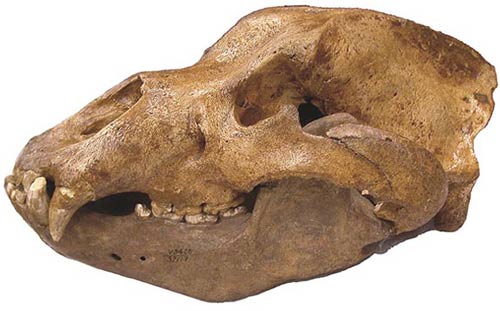New discovery about a stone predator
Ancient people used to exist in an environment full of enemies, from cats and wolves to giant raptors. Scientists have just added bears to the list above, prehistoric bears are larger than today's 1/3.
Previously, scientists believed that cave bears were herbivores living on forest fruits and roots. But bones are obtained from the Carpathians - the famous mountain thanks to the legends of Dracula - suggesting that the bear may be a carnivore, even human flesh.
Analysis of bone samples
Cave bears (Ursus spelaeus) are named after the location of their bones - caves throughout Europe, they became extinct about 20,000 years ago when the earth sunk.
In the last 30 years, studies of the skull, jaw and teeth show that cave bears are mostly herbivores. In addition, bones found in central and western Europe have a lower content of nitrogen-15 and its nucleus than the one atomic nitrogen-14, as low as those of vegetarians. Animals accumulate nitrogen-15 in the body and predators have higher nitrogen-15 than plant-eating animals.
Currently, black and brown bears are omnivores. This means that although cave bears are mostly plant-eaters, some other groups may be carnivores. New data from Petera cu Oase (Bone Cave) belonging to the southwestern tip of the Carpathians, Romania revealed that most cave bears living here are clearly carnivorous thanks to the determination of high nitrogen-15 .

Skull of a Pleistocene cave bear (Photo: LiveScience)
Hidden cave
Obtaining these bones is not easy. Max Planck, an evolutionary Institute of Anthropology in Leipzig, Germany said: 'To enter this cave must go underground.' The cave that the once used bears had collapsed for a long time, so people had to enter by a lower place, through a stream and an underground river. To reach the Petera cu Oase, which was discovered by Romanians, diving equipment and climbing gear were used.
Joao Zilhao, Stone Age archaeologist at Bristol University, UK said: 'You can imagine how hard your daily work is for the archaeological team and full of dangers.'
The battle between bears and people
Research suggests that cave bears may have to seize prey with humans and other contemporaries like hyenas, wolves and cave lions as well as brown bear omnivores.
Also according to Michael Richards: 'It is interesting if we can investigate more cave bears in other locations in the region to find more carnivorous bears. We also hope to find out why some bears are carnivorous while others eat grass. '
Scientists assume that some cave bears may eat fish, but according to University of Arizona animal archaeologist Mary Stiner, it is possible that these bears eat all of the same species.'In brown bears, cannibalism and eliminate enemies go together like in lions. This behavior is evident in the large teeth mark of cave bears in the skulls of the cubs at Yarimburgaz Cave, western Turkey. '
The research results reveal the possibility of humans and Neanderthals intentionally placing cave bear bones in these caves in ancient times. Richards told LiveScience: 'These actions may be a kind of belief and I cannot understand why cave bears are attractive to humans while they are enemies.'
The international team published their study on the January 7 online newsletter of the National Academy of Sciences.
- Huge gigantic discovery near Stonehenge stone circle
- 'Blue Stonehenge' - discovery from British archaeologists
- Detecting an ancient stone site built Ho's Citadel
- Revealing 'heavenly' about Stonehenge observatory
- Partial discovery of crucifix crucifixion Jesus?
- The phenomenon of 'plastic hybrid stone' - The consequence of pollution
- Detecting 14 stone bars like Tuy An stone herd
- Strange story about the 12,000-year-old stone ball
- Strange healing ways of Stone Age people
- Mysterious stone glows, radiates strange gas in Mexico
- Detecting mysterious stone statues in China
- Mysterious universe hidden in natural gems
 Discovered an ancient centipede fossil 99 million years old
Discovered an ancient centipede fossil 99 million years old Discovered bat-like dinosaurs in China
Discovered bat-like dinosaurs in China Discovered a 200-year-old bronze cannon of the coast
Discovered a 200-year-old bronze cannon of the coast Discover 305 million-year-old spider fossils
Discover 305 million-year-old spider fossils